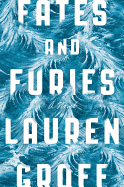
Fates and Furies opens on a beach, where young newlyweds Lotto and Mathilde are clutching each other furiously, stripping down behind the dunes to consummate their marriage. Like so many moments in the cinematic novel, it's an image that brands itself upon the brain, wavering in the distance between reader and narrator like a mirage. Pan out and the vision falters; the more the reader sees, the more unknowable these characters become.
Fates and Furies concerns itself principally with this liminal space of the individuals and their marriage, the precipitous balance between information shared and withheld. After the omniscient glimpse at Lotto and Mathilde's coupling, the narrator follows Lotto, whose unhappy Florida childhood and boarding school adolescence culminate in a stint at Vassar as the resident theater ham. There, he meets Mathilde: quiet, mysterious, a devastating wraith. Together, they balance artistic ambitions (often thwarted) with the daunting reality of the electric bill.
From the get-go, Lotto's dog-like bravado and need to be liked proves irksome, and when the novel switches after a bombshell plot twist to Mathilde's savvier perspective, it's a welcome shift. The rosy glow of Lotto's memories are suddenly recast in bare light. Mathilde's realism proves a stark contrast to her husband's romanticism, bordering at times on callousness, but inhabiting two such different minds hammers home Lauren Groff's (Arcadia) elegant examination of marriage's false promises. One can't, after all, ever know someone entirely, and in Groff's capable hands, Lotto and Mathilde prove rife with mysteries beneath their glossy surfaces. --Linnie Greene, freelance writer

